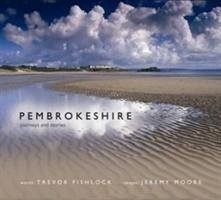| Pembrokeshire Pictured |
Places |
| Jeremy Moore- Pembrokeshire Journeys and Stories , Gomer , March 5, 2012 |
 Jeremy Moore is photographer for “Pembrokeshire Journeys and Stories”, his images augmented by text by Trevor Fishlock. It is the best book on Pembrokeshire. Jeremy Moore’s contribution to this luminous celebration of Wales’ westernmost county comprises one hundred and eighteen photographs. Moore is not just present on coast and islands. He is witness to orchids, lilies and lichen. When sighting Skomer he takes the long view of veils of mist and the close-up view of a pertly posed puffin.
Jeremy Moore is photographer for “Pembrokeshire Journeys and Stories”, his images augmented by text by Trevor Fishlock. It is the best book on Pembrokeshire. Jeremy Moore’s contribution to this luminous celebration of Wales’ westernmost county comprises one hundred and eighteen photographs. Moore is not just present on coast and islands. He is witness to orchids, lilies and lichen. When sighting Skomer he takes the long view of veils of mist and the close-up view of a pertly posed puffin. Moore has an item of equipment alongside camera and array of lenses. It is an alarm clock. He has walked a slight way out of St Dogmael’s and captured a double twist in the last miles of the Teifi’s course. His picture takes in Gwbert’s hotel and Cardigan island. The crispness of sea and cloud and the shadows cast by the trees suggest that he has risen to catch an early sun in the east. Moore is present in Lower Fishguard for the other end of the day. The town has the narrowest A-road in the world. The harbour’s location is enclosed and the slopes are thick with trees. Moore’s composition of a dozen vessels set against blue houses and hillside is caught in the low sun of a western sky. Milford Haven at late dusk- chimneys in the background, a flock of birds to the fore- is a palette of striated reds. Pentre Ifan is shot from low down, a perfect evening blue interrupted only by the tiniest sphere of a full moon. Traeth Llyfn at Abereiddi is a smouldering marriage of water in froth and a sun three-quarter hid behind cloud. Landshipping has a series of jutting pieces of land in parallel interspersed between blues, yellows and the greys of shallow water. The estuary of the Nevern, shot from Newport’s bridge, is two pieces of black land that converge between expanses of mirrored cloud and river. The photographer has been at work in all seasons. He has been at the Cleddau again in a time of mist that makes the season unguessable. Carew’s mill is mirrored in its tidal pool in lambent tones that resemble a Whistler canvas. At St David’s his time of year has been winter with a frosty path leading to the Bishop’s Palace in sun. Bedd Arthur on the Preselis is snow-covered. Pembrokeshire is cliff and water and on occasion the pictures attain meditative abstraction. Newgale beach from on high becomes pure pattern and abstraction. The green water at Dale with small lines of reflected sky contains seven parallel reflections from objects above but unseen. Twin windows in silhouette at Pembroke Castle have a gothic simplicity. The composition catches the ends of branches in bloom and a single dove. Moore has travelled as far west as is able. His picture from Grassholm has dozens of gannets in the air and hundreds standing or seated on the rock. Historical Pembrokeshire is seen from across the centuries. The medieval church at Cwm-yr-Eglwys is left with its single wall after a great gale has taken away the rest of the building. Stackpole’s pier is a few miles away from the West Blockhouse Fort guarding the entrance to the Haven. A wall from the Kilgety iron works at Stepaside comprises three circular window and three doorways capped with semi-circular apses. Pembroke Dock’s Victorian pump house now sits sadly alone on a roundabout. In the background are six tall land-posts, a garage forecourt and the bright yellow-on-blue marque of a German-owned supermarket. It reads like a caustic metaphor for a land that has lost its industry and much else besides. |
Reviewed by: Adam Somerset |
This review has been read 477 times There are 46 other reviews of productions with this title in our database:
|
